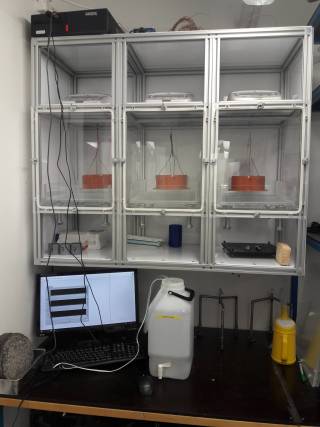 The aim of the experiment is to determine the water absorption factor, capillary saturation moisture content, and water penetration coefficient of the material. The sample is suspended from the scales above the water container so that the bottom of the sample touches the surface of the water. The test is based on the mass change of the sample as it absorbs water. The increase in weight is linear as a function of the square of time. Once the sample reaches its capillary saturation moisture content, the increase in weight stops or slows radically. From the resulting graph, the water absorption factor, capillary saturation moisture content, and water penetration coefficient can be calculated.
The aim of the experiment is to determine the water absorption factor, capillary saturation moisture content, and water penetration coefficient of the material. The sample is suspended from the scales above the water container so that the bottom of the sample touches the surface of the water. The test is based on the mass change of the sample as it absorbs water. The increase in weight is linear as a function of the square of time. Once the sample reaches its capillary saturation moisture content, the increase in weight stops or slows radically. From the resulting graph, the water absorption factor, capillary saturation moisture content, and water penetration coefficient can be calculated.
The area of the sample’s absorption surface must be at least 50 cm², but the recommendation is over 100 cm². The height of the sample depends on the pore size of the material. If the pores are small, a thin sample is recommended, and if the pores are bigger, a thicker sample is recommended.
